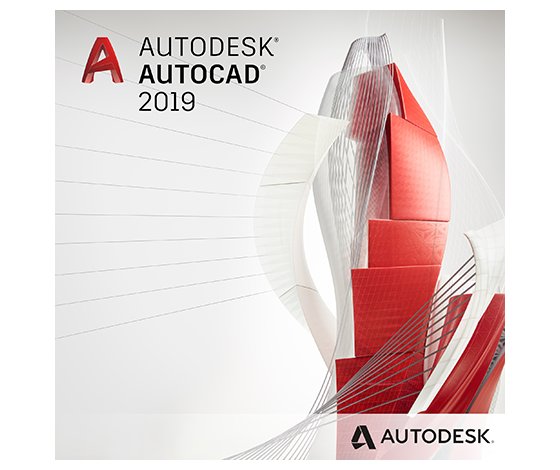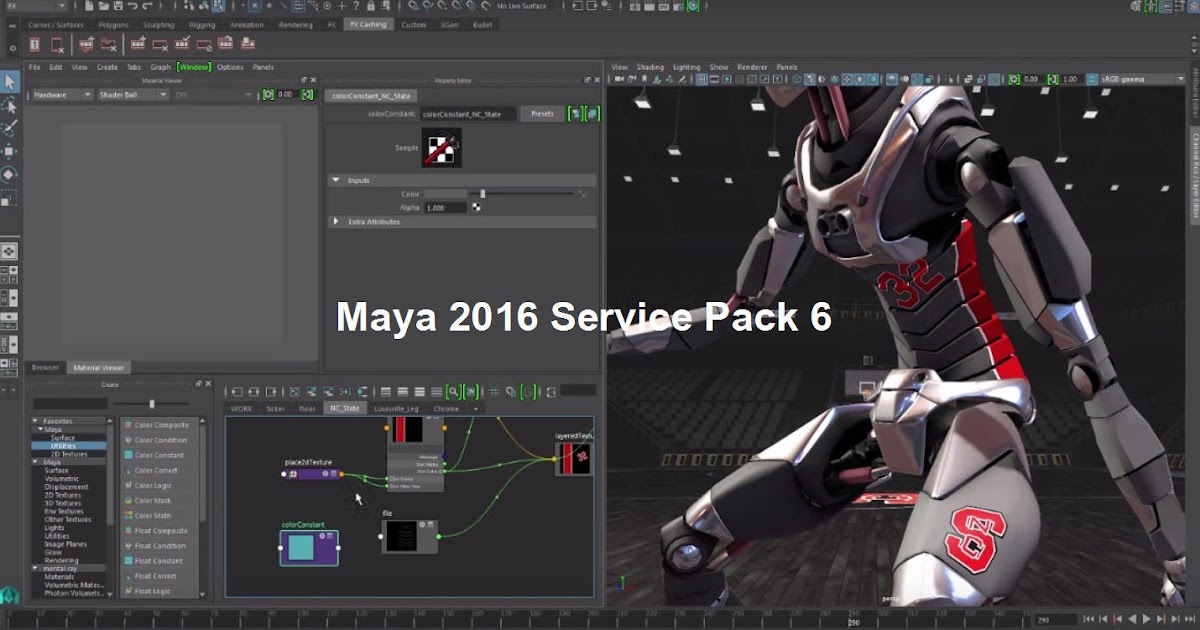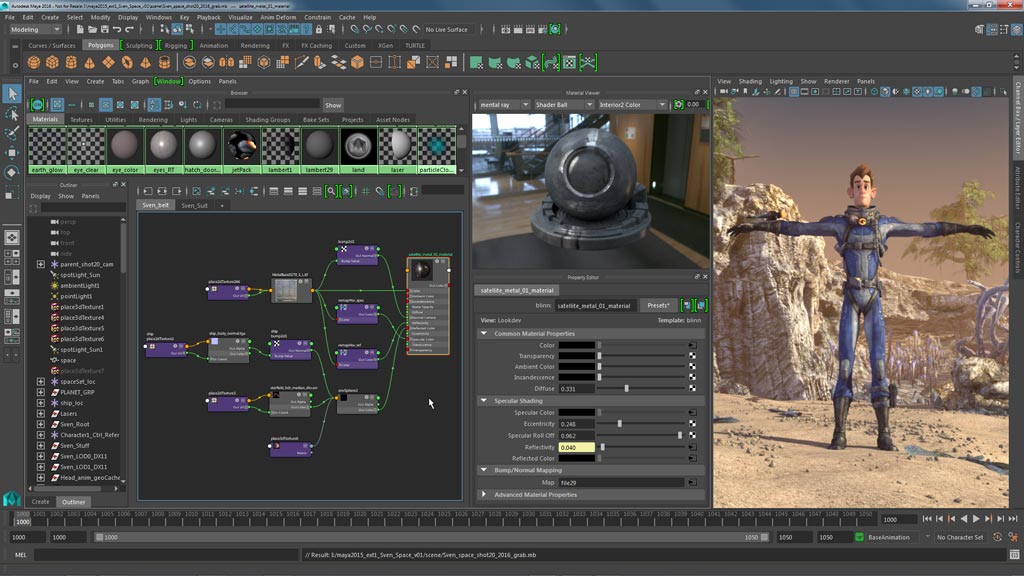Table of Contents
Mac OS X 64-bit Maya 2016 vrayadv35201maya2016mavericksx64.app Mac OS X 64-bit. It will allow you to use V-Ray in Maya, do Distributed. V-Ray 3.10.01 for Maya 2014-2016 64 bit. V-Ray 3.10.01 for Maya 2014-2016 64 bit Win 149 MB. Built to meet the creative demands of CG artists and modern production pipelines, V-Ray for Maya is a full suite of physically-based lighting, shading and rendering tools tightly integrated into Autodesk Maya.
VRayScatter For Maya is a plug-in for Maya which works with V-Ray rendering system. It is possible to create complicated scenes with a huge amount of objects easy and quickly with the aid of this plugin.
Usually scenes in Maya with a great amount of even identical objects take a lot of space on HDD, consumes a lot of time for loading, and it is very hard to work with. VRayScatter For Maya is created to solve these problems.
The scene containing 500 000 identical objects created with Maya 2008 occupies 1400Mb of HDD space. Now, if it is created with VRayScatter For Maya and still containing the same 500 000 objects the scene can take just 250Kb.
The most exciting feature of VRayScatter For Maya is a quick generation of an array of objects right before rendering. Those very 500 000 objects are created in only 2 seconds before rendering.
Another outstanding VRayScatter For Maya ability is uploading and downloading from VRayProxy memory if needed (as and when necessary). This allows the application of polygon models without missing productivity and capacity of RAM. Animated objects support and animated VRayProxy support allows creating huge amounts of animated objects. Now with VRayScatter For Maya it is possible to create the whole forest of wind-shaken woods. The support of 64-bit systems and multi-core processing allows VRayScatter For Maya to create and render, for example, forest or even a city in a blink of an eye.
Operating system:
- Mac OS X
Maya versions:
- Windows: 2016, 2016.5, 2017, 2018, 2019, 2020
- Linux: 2016, 2016.5, 2017, 2018, 2019, 2020
V-Ray versions:
NOTE:
- User must be able to obtain root permissions (using sudo, for example) to install VRayScatter For Maya.
Rendernodes:
- VRayScatter without activation supports only batch render from command prompt (render.exe or mayabatch.exe) and rendering with vray standalone.
- For rendering from Maya GUI (render→batch render) activation is required
Version 3.x.x and 4.x now uses only one V-Ray plugin file and since version 4.514 installs only a module, so you have to remove old conflicting plugins:
- Windows: uninstall previous version of VRayScatter For Maya using the uninstaller.
- Linux: remove libvray_GeomRamProxy.so and libvray_TexVRayScatter.so from /usr/autodesk/maya<MAYA_VERSION>-x64/vray/vrayplugins/
- OS X: remove libvray_GeomRamProxy.so and libvray_TexVRayScatter.so from /Applications/Autodesk/maya<MAYA_VERSION>/Maya.app/Contents/vray/vrayplugins/
- DR nodes: manually remove libvray_GeomRamProxy.* and libvray_TexVRayScatter.*
Installation

Please, make sure that you've downloaded the latest version of the plug-in from our forum
To install the program you need to run the VRayScatterForMaya-<version>.exe with the administrator rights.
please note, since version 4.514, installs only a module
Don’t forget to quit Maya before you start the installation (please check Task Manager too for any running instances of Maya).
Read the license agreement carefully. If you accept the license the click “I Agree” otherwise press “Cancel”:
Choose Maya and V-Ray versions:
Check installation paths
Start Maya and enable Load and/or Auto load in Window → Settings/Preferences → Plug-in Manager for the VRayScatter plug-in.
Installation on Windows Rendering nodes
Batch Rendering
install same as workstation but without activation
or manually copy files
Distributed Rendering
Copy vray_VRayScatter.dll from MAYA_ROOTplug-insvrayscattervrayplugins to VRAY_STANDALONE/vrayplugins (or MAYA_ROOT/vray/vrayplugins) on render nodes.
(or whichever folder is used for loading vray plugins from, the folder is usually called /vrayplugins and locates within your V-Ray installation)
For example, from:
to:
Uninstall
To uninstall VRayScatter use the uninstaller: Start menu > R&D Group > VRayScatter For Maya > Uninstall
Activation
please see:http://docs.rendering.ru/en:cerber-protection
General
Please, make sure that you've downloaded the latest version of the plug-in from our forum
Installation On Linux
Please, make sure that you've downloaded the latest version of the plug-in from our forum
Unpack the archive, open your preferred terminal application, obtain root permission
Installer has a graphical interface on all supported platforms:
or you can also run text installation mode
Select you Maya/V-Ray versions, files will be copied to the following folders according to your setup, e.g:
NOTE:
- Change the installation paths depending on your setup
- change paths in VRayScatterForMaya.mod file according to your environment, if needed
Installation On Linux Render Nodes
Batch Rendering
Same as for workstation, but without activation
Run installer, extract files and then copy across rendernodes
And check .mod file for variables
Distributed Rendering
For V-Ray “Distributed Render” node installation you only need to copy V-Ray plugin file libvray_VRayScatter.so e.g :
Uninstall
To uninstall VRayScatter For Maya you have to manually remove all the installed files.
Activation on Linux
please see:http://docs.rendering.ru/en:cerber-protection
Installation on Mac OS X
Please, make sure that you've downloaded the latest version of the plug-in from our forum
Unpack the archive, open your preferred terminal application, obtain root permission and start coping files:
Select you Maya/V-Ray versions and copy the plugins. Here is an example for the default paths of Maya 2012 and V-Ray 2.2:
Install the Maya UI files:
Vray For Sketchup Mac Crack
Install the V-Ray texture description file:
NOTE:
- Change the installation paths depending on your setup
- # - means that command should be executed with root permissions
Installation On Mac OS X Batch Render Nodes
Change directory to where you have unpacked the archive:
Select you Maya/V-Ray versions and copy the plugins:
Install the V-Ray texture description file:
Installation On Mac OS DR Nodes
For V-Ray “Distributed Render” node installation you only need to copy V-Ray plugins:
Uninstall
To uninstall VRayScatter For Maya you have to manually remove all the installed files.
Activation on Mac OS X
NOTE
Please make sure you always use the registration utility which is supplied with the particular version of VRayScatter For Maya.
Open your preferred terminal application and start the registration utility:
This will generate an VRayScatterForMaya_<UserName>_<Date>.id file on your Desktop.

Send this file to mail@rendering.ru (or your reseller). Please, attach copy of you receipt or order number to avoid any delays in communication.
In the nearest time (usually within 24 hours) you will get an email from us (or your reseller) with *.lic license file attached. Save this file on your hard disk.
Start again the registration utility with the path to the license file argument like:
or manually copy this file to ~/.config/RDGroup/VRayScatterForMaya.lic like this:
In case of license malfunction and errors (which can be caused by disk formatting, reinstallation of the operating system or components replacement) you are free to address the developer at any time. Please make sure you download latest version from our forum and generate new *.id file. Send it to mail@rendering.ru to get your updated *.lic file.
However, we reserve the right not to issue a new license in case of total replacement of a PC if the registration request is submitted more often than once in half a year.
ATTENTION! Please always try to email from the same email address you used when you purchased the plug-in. If we can’t find your e-mail address from which you sent the ID file in our database and there is no explanation and receipt or order number in you email, your request may not be processed!
Please always attach you receipt or order number to avoid any delays in communication.
VRayScatter Creation
- Select mesh or curve object you want to distribute objects at.
- In menu choose: Create → R&D Group → VRayScatter.
- VRayScatter bounding box and logo will appear. Use it to select VRayScatter.
User Interface
- Select objects to distribute (Mesh or VRayProxy) then select VRayScatter and press Add in «Scatter Objects» rollout. This will connect objects to the “scatterObject” attribute.
- If you have added multiple objects tweak the Probability parameter to make all objects visible or use menu Tools → “Auto Probability”.
Parameters Description
Scatter Objects rollout
- Color – object's drawing color in viewport.
- Probability – probability of the object's appearance.
- Radius – radius of the collision sphere for the collision solving. Default value is 100% - that corresponds to the object size.
- Height – addition offset of the collision sphere.
- Penetration – sets the blur of the collisions border areas.
- Mask color variance – threshold for colorful mask.
- Hide From Render – hide original object from render.
- Apply Geometry Transform
Distribution
- Amount – render objects amount.
- UV Set -
- Colorful - use colorful mask; this will place objects by the texture using object “Draw Color”.
- Texture
- Both
- Texture – distribution mask texture. This could be any Maya texture.
- Solve Collisions – solve scatter objects collisions.
Distribution Cache
Pattern
- Random
- Pattern 1 - Pattern distribution uses UV-mapping to work, thus object must have proper UV-coordinates.
- Pattern 3
- Use Density – random position settings include only this one additional option. With it you can set the number of objects (Count) to be located at a single area unit (Per Square). The resulting number will also be fixed with ‘Max Count’ option. The area is defined by system units. It means that in the case when centimetres being used in system units one single object will fall within 1 square meter.
- Per Square
- Lock Offsets – when this option is enabled you will to control both U and V offsets simultaneously.
- V Offset – V offset.

Rotation
- Use – quick control to enable/disable rotation features.
- Attach
- X, Z, Y
- Align To Normal – align object to surface normal.
- Random – random rotation (for each axis).
- Texture – rotation texture. Red color represents rotation around X, Blue – Y, Green – Z. Color value 0.0 equals to rotation of 180 degrees to one direction, color value of 0.5 leaves the rotation state unchanged, color value of 1.0 makes the rotation of 180 degrees to another direction.
- Use X, Y, Z – quick control to enable/disable rotation about each axis when using texture.
- Texture contrast – quick control of texture contrast.
Scale
- Use – quick control to enable/disable scale features.
- Global From/To – global minimum/maximum scale. The actual scale will be a random value between From and To values.
- Local From/To – per-axis minimum/maximum scale. The actual scale will be a random value between From and To values.
- Texture – scale texture. Red color represents X scale, Blue – Y, Green – Z.
- Max Scale – maximum scale that corresponds to the 1.0 color value.
Offset
- Use – quick control to enable/disable offset features.
- Along Normal – offset objects along surface normal.
- From/To – minimum/maximum offsets. The actual offset will be a random value between From and To values.
- Use Texture – Use offset texture.
- Texture – offset texture. Red color represents X offset, Blue – Y, Green – Z.
- Max Offset – maximum offset that corresponds to the 1.0 color value.
Slope Control
- Invert
- World Space
- From/To
- Invert
Mirror
Distance to surface borders
Vray For Maya Tutorial
- Use – quick control to enable/disable surface border features.
- Distance – maximum distance from object to surface border in which object parameters will be affected. Actual control parameter behaviour could be defined using Density and Scale ramps.
- Affect Scale
- Selected Position
- Interpolation - None, Linear, Smooth, Spline
- Selected position
- Interpolation - None, Linear, Smooth, Spline
Distance to curve
- Use – quick control to enable/disable curve border features.
- Distance – maximum distance from object to curve in which object parameters will be affected. Actual control parameter behavior could be defined using Density and Scale ramps.
- Affect Scale
- Curve Border Density Ramp
- Selected Value
- Curve Border Scale Ramp
- Selected Value
Mask curve
- Use – quick control to enable/disable mask curve features.
- Projection Plane
- Mask Curve Attach – attaches selected curve.
Camera
- Use – quick control to enable/disable camera features.
- Use FOV – limits rendered objects to only that are seen from camera field of view. Could save some RAM.
- Distance Far – distance from camera.
- Affect Density – limits objects visibility to distance.
Render
- Use Light Linker - this feature will transfer Light Linker setup from objects used in scatter to instanced objects.
- Use Subdivision / Displacement
- Tint Texture - check VRayScatter Texture section for howto.
- Visibility
- Visible To Camera
- Visible To Refractions
- Render ID Mode
- Instance Render ID
- Unique Per Instance
- Custom Object ID
- Instance / Proxy Object ID
- Motion Blur
- Motion Blur and Velocity Channel
- Use Rayserver Instancer (WIP, Next)
VRayProxy Animation
This feature works only when scattering VRayProxy and allows to assign different frame offset.
- Offset From/To – From/To frame offset. Actual frame offset is a random value between From and To.
- Use Offset Texture - use texture to drive frame offset; black = “Offset From” value, white = “Offset To” value.
Viewport
- None
- Box
- Draw Alpha
- Logo color - color for the locator logo and bounding box.
Bake
This feature allows to “bake” scattered objects to real Maya objects. Use this feature very carefully because it could add too many objects to your scene.
- Preview
- Bake Type
- Instance - new objects will be linked with one geometry.
- Duplicate Input Connection
Textures
VRayScatter Texture
VRayScatter texture is used for color randomization of scattered objects.To use this feature do the following:
Setup VRayScatter:
- Enable “Use Tint Texture” option in VRayScatter's “Render” rollout.
- Setup “Tint Texture”. You could use any Maya texture to control color variance (like Noise or File)
Setup scattered object (this example uses diffuse color variance):
- Add “VRay Scatter Texture” to diffuse slot. “VRay Scatter Texture” is located in “Utilities” section in Maya textures.
- Add “Base Texture” to “VRay Scatter Texture” if needed
Now render your scene and look at color variance.
License error
if this is happens right after activation, please restart Maya
In case of license malfunction and errors (which can be caused by disk reformatting, re-installation of the operating system or components replacement) you are free to address the developer at any time by sending your request for a new *.LIC file to mail@rendering.ru.
Does not appear in create menu
- Please make sure all files were placed into right folders.
- Start Maya and enable Load and/or Auto load in Window → Settings/Preferences → Plug-in Manager for the VRayScatter plug-in.
Log
Check your log for any errors, also from version 4.405.154 you can now setup environment variable ICUBE_DEBUG to 1, this will produce more info from VrayScatter
Other errors
Please make sure you download and install latest version from our forum
If this haven't solved the problem please contact us at mail@rendering.ru, by sending description of the problem together withthe following information:
- Maya version
- Some screenshots will be useful
Vray For Maya Torrent
We know that architects and designers love SketchUp’s ease of use and quick modelling features, so we built a version of V-Ray for SketchUp 2018 + Key which seamlessly slots into its simple work environment. And our users love it, fot that V-Ray’s twin-engine rendering architecture uses full advantage of the latest Processor or Graphic card hardware. And with its complete set of tools, rendering from quick design concepts to your most detailed 3D models will be easy. You Can also Download Vray 3.40.01 for Rhino Full Version+Crack & Vray 3.40.02 for SketchUp 2017 full crack.
V-Ray for SketchUp 2018 + Key Features
- ACCURATE LIGHTS
- ENVIRONMENT LIGHTING
- PHYSICAL SUN & SKY
- FOG & AERIAL PERSPECTIVE
- REAL-WORLD CAMERAS
- VIRTUAL REALITY
- PHYSICAL MATERIALS
- ADVANCED TEXTURES
- FRAME BUFFER
- RENDER ELEMENTS
- V-RAY SWARM
- PROXY OBJECTS
- GRASS
- SECTION CUTS
- CPU & GPU RENDERING MODES
- V-RAY DENOISER
Vray Maya
The desktop 3D applications that are supported by Vray for Sketchup 2018 Crack are:
- 3ds Max
- Cinema 4D
- Maya
- Modo
- Nuke
- Rhinoceros
- SketchUp
- Softimage
- Blender
What’s New In V-Ray for SketchUp 2018 Full version + Crack
- Viewport rendering
- Powerful GPU & new hybrid rendering
- Asset manager
- New V-Ray color picker
V-Ray for SketchUp 2018 + Keygen System Requirements:
- For Mac, it is most extreme with 1+ GHz Intel™ processor.
- For windows, it is most extreme for SketchUp 2013, 2014, 2015, 2016, Windows Vista, Windows 7, Windows 8 with a processor that is 1GHz 1 GB RAM.
- The framework should have 16 GB circle that is space that’s hard 300 MB plate space that is free.
How To Install & Download V-Ray for SketchUp 2018 With Crack
Vray Crack Download
- Download files from the given link
- Turn off internet connection and run .exe file
- Select the product and generate VRay for SketchUp 2018 Serial Key
- Copy it and paste it in the required box
- Click register and wait for the completion process
- You have successfully registered VRay for SketchUp 2018 Crack Latest Full Version
- Enjoy to use VRay for SketchUp 2018 full version free.